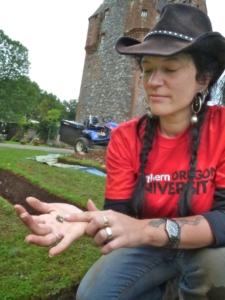SOU Archaeologist Brings Pieces of Victorian Scotland to Ashland
(Ashland, Ore.) — The dumps and compost piles of yesteryear may seem like an unlikely place to learn about culture, but discarded items reflect society, educating anthropologists on what people ate, wore, used as tools and other insights into daily life.

Chelsea Rose, an archaeologist with Southern Oregon University’s Laboratory of Anthropology, holds a piece of 18th-century ceramic after digging at Amisfield Tower in southern Scotland this summer.
Chelsea Rose, an archaeologist with Southern Oregon University Laboratory of Anthropology has discovered exactly that after years of digging in Scotland. This summer, she went back to Scotland for the fifth time, digging at Amisfield Tower—a Scottish border tower completed in 1600—and an area inhabited since prehistoric times. Located in the southern Scotland area known as Dumphriesshire, the tower was built by the Charteris family, who arrived in Scotland with William the Conqueror.
“Last year we explored the landscape to see what was there. This year we targeted certain areas—one area ended up being a medieval garbage dump. We found bones from the food people were eating, coins, a piece of carved ivory and a lot of medieval pottery,” Rose said.
“Lamb—they ate a lot of lamb,” she added.
Rose says the digs have barely scratched the surface of the archaeology at Amisfield, and there is so much more to learn about southern Scotland’s medieval time period. Nineteenth- and twentieth-century items from the last two excavataions are currently being examined and catalogued at SOU, and will be used in Rose’s ongoing research into global Victorianism.
The digs are funded by East Coast-based First Landing Foundation and include several other archaeologists. For the first three years, the team researched the childhood home of John Paul Jones, who is considered by some to be the father of the U.S. Navy. He was raised on Arbigland Estate, overlooking the Solway Firth in southwest Scotland.
Rose hopes to make it back next year. In the meantime, she, along with SOU archaeology students, are working with items she brought back this summer, piecing things together for a better understanding of Victorian Scottish life.
“We’re looking at ceramics and glassware that dates from the 1840s through the early twentieth century. They’ve all been cleaned and catalogued. Now we’re going to see how they fit together.”
“So far, artifacts in the Scotland collection look very similar to the types of things we found last year at the Peter Britt homestead. We look forward to comparing these two collections directly, and investigating the similarities and differences between life in the Scottish borderlands and the American frontier.”
[icitspot id=”809″ ]

Leave a Reply
Want to join the discussion?Feel free to contribute!